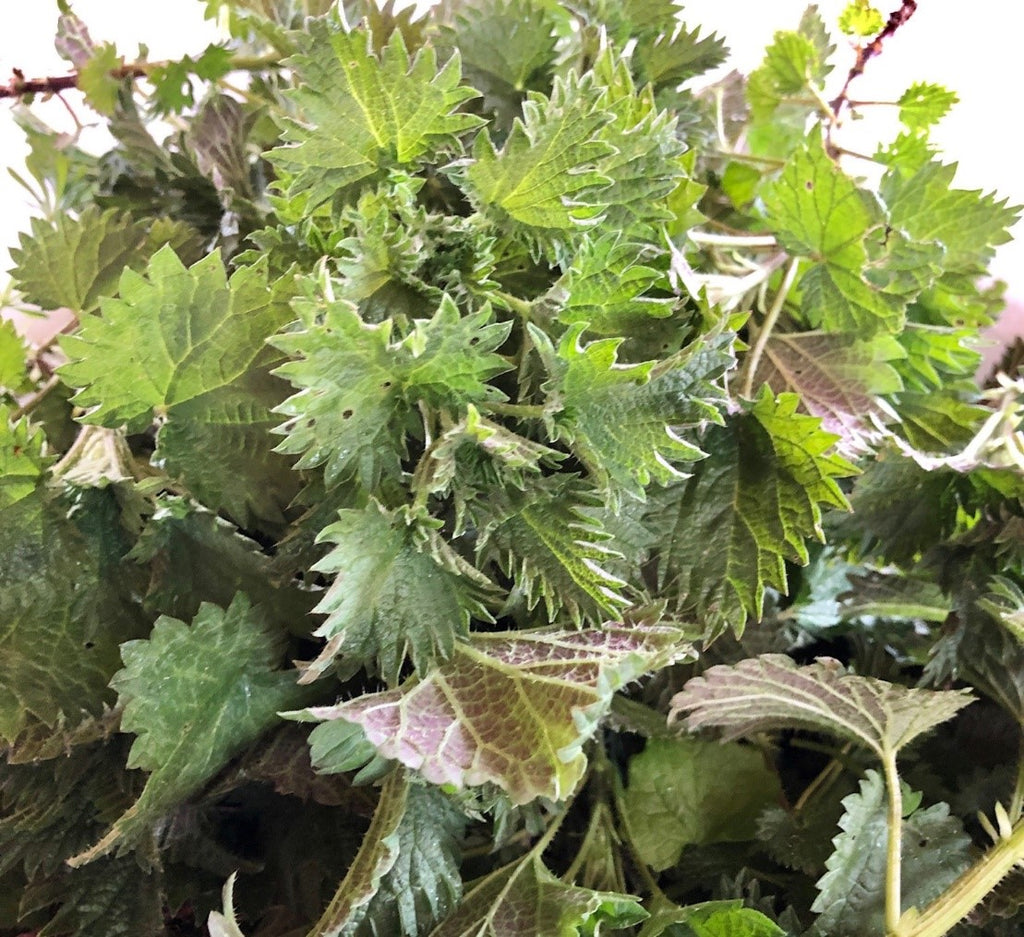LET IT GROW - Part 2: Stinging Nettle

LET IT GROW! Part 2: Stinging Nettle.
Botanical name: Uritica dioica.
Parts used : leaves, seeds, roots.
Have you ever accidentally touched nettle leaves and felt a slight stinging or prickly pain? While you may curse the plant for the temporary discomfort, stinging nettle is actually a beneficial perennial that treats several conditions. It’s leaves for nettle tea is a common natural allergy relief remedy. It’s also proven to benefit skin, bone and urinary health as well.
Stinging nettle is a common plant that grows in the United States, Canada, and Europe. It primarily grows in damp, fertile soil. The nettle has sharp hairs on its leaves. These hairs contain chemicals, such as formic acid and histamine that can irritate the skin and cause stinging, itching, and redness. Stinging nettle hairs also contain a range of other chemicals that can affect humans, including acetylcholine and serotonin.
Ancient civilizations used stinging nettles to treat various ailments. For example, Ancient Egyptians used stinging nettle infusions to treat arthritis. Some people still use stinging nettle as a medicinal aid today. Back in ancient Greek time, stinging nettle has been used medicinally. The plant usually grows between two to four feet high and blooms from June to September. Stinging nettle contains a number of chemicals such as serotonin and acetylcholine which can be very irritating.
Nutrition fact of stinging nettle (per 100g)

According to NutrituionFact.org, one cup of nettle tea is pack of :
- Iron that equal to a whole dry apricot
- Zink that equal to a pumpkin seed
- Copper that equal to 20 wild mushrooms
- Magnesium that equal to 4 peanuts
- Calcium that equal to an entire fig
Benefit of Stinging Nettle:
According to the University of Maryland medical center, the plant has been used as a diuretic and for treating painful muscles and joints, eczema, arthritis, gout. Stinging nettle above ground parts are used along with large amounts of fluids in so-called “irrigation therapy” for urinary tract infections (UTI), urinary tract inflammation, and kidney stones (nephrolithiasis). The above-ground parts are also used for allergies, hay fever and osteoarthritis.
- Benign Prostatic Hyperplasia (BPH) and urinary issues. Nettle root is used for urination problems related to an enlarged prostate (benign prostatic hyperplasia [BPH]). These problems include nighttime urination, too frequent urination, painful urination, inability to urinate, and irritable bladder.
- Osteoarthritis and joint pain : studies shows that applying nettle leaf topically at the site of pain decreases joint pain and can treat arthritis. (1)
- Hay fever: Stinging nettle has anti-inflammatory qualities that affect a number of key receptors and enzymes in allergic reactions like uncomfortable congestion, sneezing itching, etc. A study shown that nettle can prevent hay fever symptoms if taken when they first appear. (2)
- Bleeding: some people use the above ground parts of stinging nettle for internal bleeding, including uterine bleeding, nosebleeds, and bowel bleeding. A study shown that a product call Ankaferd Blood Stopper can reduce bleeding after dental surgery, stinging nettle is one of the ingredients. (3)
- Eczema: Eczema is a dry, itchy rash that can last on sufferers for a very long time. Because of stinging nettle’s antihistamine and anti-inflammatory qualities, it can be a natural treatment for eczema.
How to use stinging nettle:
There are many receipts of stinging nettle can be found online, the finished pack loose nettle tea is also available from many websites. I like to use fresh nettle leave that I pick up from the green field, use them fresh or sun dry them. I enjoy this process, it is not only fun but also quite healing, especially when you enjoy the result (drinking your homemade nettle tea and reading a book in the garden), the satisfaction feeling is far more than the dry nettle tea you bought online. If you also interested in making nettle tea from start, remember only harvest the youngest, freshest, top 2-3 sets of leaves as they are the most tender. Do not harvest the leaves after nettles have flowered.
Always use gloves to avoid the stinging hair. Don’t worry stings are broken down with cooking and blending.
Nettle tea
With fresh leaves, experiment with the ratio of nettle to water you prefer, I prefect two cups of water for every cup of leaves. Here’s how:
- Add water to the leaves.
- Bring the water just to a boil.
- Turn off the stove and let sit for five minutes.
- Pour the mixture through a small strainer.
- Add a bit of honey, cinnamon if you like.
Nettle tea is safe as long as you 1) don’t drink too much, 2) don’t mistake with white dead nettle (Lamium album) and 3) don’t put the leaves in your mouth fresh–they don’t call them stinging nettles for nothing!

Nettle soup

Half a basket of stinging nettle tops, or fresh-looking larger leaves
- 50g butter
- 1 large onion (or a dozen crow garlic bulbs if you want to be truly wild), peeled and finely chopped
- 1 liter vegetable or chicken stock, or even light fish stock
- 1 large potato, peeled and cut into cubes
- 1 large carrot, peeled and chopped
- Sea salt and freshly ground black pepper to taste
- 2 tbsp crème fraiche
- A few drops of extra-virgin olive oil
- A few drops of Tabasco (optional)
- Wearing rubber gloves, sort through the nettles, discarding anything you don't like the look of and any thick stalks. Wash the nettles and drain in a colander.
- Melt the butter in a large saucepan, add the onion and cook gently for 5-7 minutes until softened.
- Add the stock, nettles, potato and carrot. Bring to a simmer and cook gently until the potato is soft, about 15 minutes.
- Remove from the heat. Using an electric hand-held stick blender, purée the soup and then season with salt and pepper to taste.
- Add a teaspoonful of creme fraiche floating on top of soup. Add a few drops of extra-virgin and Tabasco.
When nettle is cooked, it has a flavor similar to spinach and cucumber mix, it has a great source of vitamins A, C, protein and iron.
Nettle hair tonic for Dandruff
This hair rinse contains mineral-rich herbs, it is antifungal and stimulates circulation in the scalp, helping clear away flakiness and shine the hair, ideally for dandruff.
- A handful of fresh or dried nettle leaves
- A handful of fresh or dried rosemary leaves
- A handful of fresh or dried sage leaves
- 10 drop of tea tree essential oil (optional)
- 1 litre boiling water
- 50ml organic apple cider vinegar
Put the herbs into a blow, pour over the boiling water and leave to infuse until the temperature is cool down. Strain out the herbs and add the cider vinegar to the liquid. Use the spray after normal hair wash, no need to wash it out.
STINGING NETTLE OINTMENT FOR OSTEOARTHRITIS (140g)
before making nettle ointment, you need to make nettle infused oil
For making nettle infused oil

- A handful of fresh nettle leaves (including stems)
- Enough sweet almond oil (or other vegetable oil) to cover
Take the clean, dry, freshly picked nettle leaves (remember to use glove for protection), lightly dust with sieve and wash well in clean salt water. Place nettle leaves in a clear jar then cover with oil. Make sure the oil is enough to cover the leaves. Leave to infuse for around 4-6 weeks then strained with cheese cloth after.
You can also use quick bain-marie method to make infused oil in one day. Place the nettle oil jar in a pan fill with water, the water should reach at least one third of the jar, use the low heat heating for 6 hours.
For making Stinging Nettle ointment
This ointment is good for osteoarthritis and joint pain. It is safe to use a few times per day. Roman chamomile essential oil has sedative therapeutic property and balance the smell of the ointment with a little sweet flower fragrance. If you don’t have roman chamomile essential oil at hand is ok, without it will works too.
- Bee wax 20g
- Nettle infused oil 120g
- Vitamin E 1.4g (to prevent oil rancid)
- Roman chamomile essential oil 0.3g (optional)

- Gently melt the beeswax and infused oil together over a bain-marie until wax is completed melted.
- Remove from the heat and leave to cool. Stir in vitamin E and essential oil (if use).
- Pour the mixture into sterilized jars and leave to set in a cool place. Seal, label and dated. Do not wait too long to pour the mixture, when beeswax become solid, it is difficult to transfer into the jas.
Nettle & lavender dry skin nursing cream (60g)
This is a very nursing cream for dry and crack skin, Due to it is a oil base cream, so a tiny bit of cream can goes a long way!
- Bee wax 3g
- Shea butter 27g
- Nettle infused oil 29g
- Vitamin E 0.6g
- Palmarosa essential oil 6 drops
- Gently melt wax and butters in a bain-marie
- When melted, remove from the heat and add oils. Keep on stirring
- When mixture temperature under 40C add vitamin E and essential oil.
- Place mixture in a cold water bowl, stir until you can see the trace of the mixture.
- Pure the mixture into a tin and label the finished product.

Side effects of Stinging Nettle:
Always start with small amount (for internal use) and do a patch test (for external use). Even all-natural foods and drinks like tea can cause allergic reactions or interact with certain medications. Some herbs and supplements can be harmful to people with certain health conditions. If you are not sure about consuming stinging nettle, please consult with your doctor.
Stinging nettle is LIKELY UNSAFE to take during pregnancy. It might stimulate uterine contractions and cause a miscarriage. It’s also best to avoid stinging nettle if you are breast-feeding.
Reference :
(1) https://draxe.com/health/effective-all-natural-treatments-for-arthritis/
(2) https://www.ncbi.nlm.nih.gov/pubmed/19140159
(3) https://www.ncbi.nlm.nih.gov/pubmed/20098971


Kommentarer til dette indlæg (1)
Best dating site: https://tinyurl.com/mbsf2vay
hDnUTxKpXPtEWdSGSGsRpxaBYtgDMGRU
— Danielbum